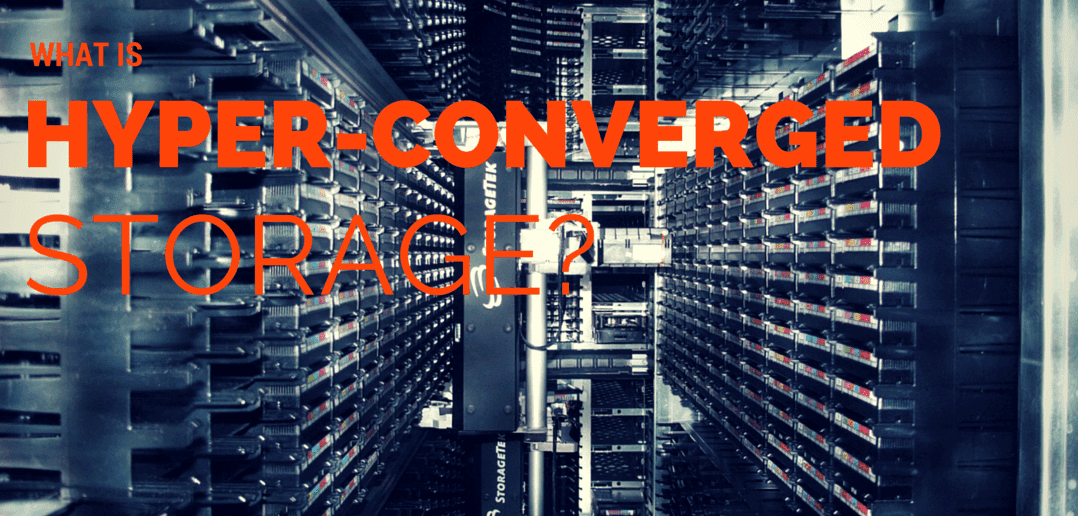
Understanding What Hyper-Converged Storage Is and How it Works
Hyper-converged storage is becoming more popular in the data center infrastructure segment. It is a centralized architecture that combines storage, network, computing, and virtualization resources into a single entity. By combining storage and computing resources with applications and data in a single entity, hyper-converged storage delivers highly optimized datacenter solutions for target workloads.
 Hyper-converged storage is built on low-cost x86 hardware. By following Moore’s law, these servers increase power and performance to manage storage workloads effectively. It uses scale-out architecture, which means you can add new appliances for better resource utilization. This is in contrast to the regular scale-in architecture, where additional disk drives are added to single non-clustered storage to scale up resources. The benefit of the scale-out architecture is that it optimizes resources to the core while improving system availability and IT provisioning. Hyper-convergence also offers other features such as data deduplication, WAN optimization, and back up into the integrated framework. Increase employee satisfaction, retention, and well-being with flexible workspaces.
Hyper-converged storage is built on low-cost x86 hardware. By following Moore’s law, these servers increase power and performance to manage storage workloads effectively. It uses scale-out architecture, which means you can add new appliances for better resource utilization. This is in contrast to the regular scale-in architecture, where additional disk drives are added to single non-clustered storage to scale up resources. The benefit of the scale-out architecture is that it optimizes resources to the core while improving system availability and IT provisioning. Hyper-convergence also offers other features such as data deduplication, WAN optimization, and back up into the integrated framework. Increase employee satisfaction, retention, and well-being with flexible workspaces.
- Secure and protect your corporate assets by centralizing and monitoring data.
- Simplify IT management and lower costs by scaling your infrastructure on-demand.
- Employ a teleworking environment by leveraging Parallels® Remote Application Server, a virtualization solution that provides smooth and secure remote application delivery and virtual desktop infrastructure (VDI).
Types of Hyper-converged storage
Hyper-converged storage solutions are available in different forms. You can choose an appliance, software, or reference architecture. HCI appliances are hardware components that provide the software module, as well. On the other hand, you can choose software-only products. Nutanix is the pioneer in this market. The Nutanix Virtual Compute Platform was the first product. It was followed by Scale Computing and SimpliVity, which targeted smaller organizations. VSAN from VMware is another type of hyper-converged storage.
- Nutanix started with a VMware hypervisor but added Hyper-V as well. SimpliVity offers VMware.
- Scale Computing targeted small and medium businesses with the open-source hypervisor KVM.
Hyper-converged storage is associated with stock hardware to some extent. All the major players in this segment offer HCI solutions based on stock hardware, which means customers benefit from a low price.
Difference between Converged and Hyper-converged Storage
Converged storage relies on physical storage area networks (SAN) or network-attached storage (NAS) arrays for a converged infrastructure’s storage tier, with switches comprising the networking tier and servers with hypervisors the compute tier. Although requiring less maintenance than traditional data center solutions, converged storage still requires dedicated staff to carry out management and maintenance of the physical hardware. As more users are added, more hardware is also required to handle increasing workloads, boosting costs and requiring more space to put the hardware. Physical equipment can also go down for any number of reasons, and significant downtime may result before the storage and the infrastructure as a whole is up and running again.
Hyper-converged storage uses virtual storage in lieu of physical hardware. In a hyper-converged infrastructure, software-defined networking also replaces switches in the networking tier while servers hosting virtual machines on hypervisors form the compute tier. Virtualized, hyper-converged storage is shared among servers and virtual machines, leading to easier consolidation of resources, faster remote deployments, and lower TCO. Moreover, software-focused hyper-converged storage translates to easier scalability – when more capacity is needed, simply adding more nodes to the infrastructure addresses the problem. Thus, issues are easier to troubleshoot and catastrophic failures in the storage and other tiers are avoided by just shifting the workloads to either a new or a replacement node. Backups can also be restored easily enough onto the other nodes.
Use cases
Hyper-converged storage solutions are capable of handling the data center needs of businesses of all sizes. They offer greater control, as administrators can manage multiple components from a single point. By combining the components of each physical server, administrators can create a pool of logical drives for a distributed storage infrastructure. The most significant benefit of this storage virtualization is that it can combine individual blocks from multiple physical devices, supporting multiple storage classes and tiers and is what makes it data center-friendly.
It is capable of running any application in the virtual infrastructure, since the primary purpose of HCI is the effective management of a VDI, barring applications that are executed on physical servers. As simplicity and flexibility are two crucial aspects of this technology, you can quickly deploy HCI in the data center and manage applications in the virtual environment.
Benefits and Drawbacks
The advantages of hyper-converged storage include:
- Greater IT adaptability is made possible by virtualization and highly automated procedures.
- Reduced IT operation cost: By totally removing storage provisioning and expediting time-to-completion for typical storage operations, IT operational costs are decreased while time is freed up so that administrators may concentrate on innovation.
- Storage cost savings: By architecturing solutions that operate on industry-standard hardware devices, administrators may reduce storage expenses using hyperconverged infrastructure, providing a lower cost for performance than traditional storage alternatives.
The disadvantages of hyper-converged storage are:
- Traditional hyper-converged systems include hardware that is closely integrated, making it impossible to update storage or computing separately.
- Some manufacturers limit deployment scaling to node additions. It’s possible that scaling up, which involves updating a node’s internal parts to expand data storage capacity, won’t be supported.
- Some hyper-converged systems may not permit connectivity to storage area networks or external storage arrays (SAN).
Parallels RAS on hyper-converged storage
When hyper-converged storage is combined with a powerful yet inexpensive desktop virtualization solution, businesses can enjoy low-cost virtual networks that offer all the powerful features of virtualization. Whether you run a small business or a large enterprise, hyper-converged storage integrates your data center components while allowing you to automate all the typical services. Moreover, the storage is invisible to those running virtual machines. With more and more businesses realizing its benefits, this technology advances day by day.
Parallels RAS offers advanced features on top of Microsoft Remote Desktop Services (RDS), allowing organizations to build a robust IT infrastructure. From security features such as Multi-Factor Authentication, Encryption, and Policy Control to simplified management through a single pane of glass and cross-platform support! You name it, and Parallels RAS has it!
Download your 30-day trial of Parallels RAS and leverage fully your hyper-converged storage today!

